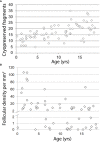A 16-year bicentric retrospective analysis of ovarian tissue cryopreservation in pediatric units: indications, results, and outcome
- PMID: 37720539
- PMCID: PMC10501795
- DOI: 10.3389/fendo.2023.1158405
A 16-year bicentric retrospective analysis of ovarian tissue cryopreservation in pediatric units: indications, results, and outcome
Abstract
Background: Cancer treatments of the last decades improve the survival rate of children and adolescents. However, chemo- and radiotherapy result in gonadal damage, leading to acute ovarian failure and sterility. The preservation of fertility is now an integral part of care of children requiring gonadotoxic treatments. Ovarian tissue cryopreservation (OTC) is an effective fertility preservation option that allows long-term storage of primordial follicles, subsequent transplantation, and restoration of endocrine function and fertility. The efficacy of this technique is well-demonstrated in adults but the data are scarce for pediatric patients. Currently, OTC represents the only possibility of preserving the potential fertility in prepubertal girls.
Procedure: This is a retrospective study of OTC practice of two French centers from January 2004 to May 2020. A total of 72 patients from pediatric units underwent cryopreservation of ovarian tissue before gonadotoxic therapy for malignant or non-malignant diseases. The ovarian cortex was cut into fragments and the number of follicles per square millimeter was evaluated histologically. The long-term follow-up includes survival rate and hormonal and fertility status.
Results: The mean age of patients at OTC was 9.3 years [0.2-17] and 29.2% were postpubertal; 51 had malignant diseases and 21 had non-malignant diseases. The most frequent diagnoses included acute leukemia, hemoglobinopathies, and neuroblastoma. Indication for OTC was stem cell transplantation for 81.9% (n = 59) of the patients. A third of each ovary was collected for 62.5% (n = 45) of the patients, a whole ovary for 33.3% (n = 24) of the patients, and a third of one ovary for 4.2% (n = 3) of the patients. An average of 17 fragments [5-35] per patient was cryoconserved. A correlation was found between the age of the patients and the number of fragments (p < 0.001). More fragments were obtained from partial bilateral harvesting than from whole ovary harvesting (p < 0.05). Histological analysis of ovarian tissue showed a median of 6.0 primordial follicles/mm2 [0.0-106.5] and no malignant cells were identified. A negative correlation was found between age and follicular density (p < 0.001). Median post-harvest follow-up was 92 months [1-188]. A total of 15 girls had died, 11 were still under treatment for their pathology, and 46 were in complete remission. Of all patients, 29 (40.2%) were subjected to a hormonal status evaluation and 26 were diagnosed with premature ovarian insufficiency (POI) (p < 0.001). One patient had undergone thawed ovarian tissue transplantation.
Conclusion: OTC should be proposed to all girls with high risk of developing POI following gonadotoxic therapies in order to give them the possibility of fertility and endocrine restoration.
Keywords: children cancer; fertility preservation; follow up; gonadotoxic treatment; ovarian tissue cryopreservation.
Copyright © 2023 Grellet-Grün, Delepine, Le Van Quyen, Avérous, Durlach, Greze, Ladureau-Fritsch, Lichtblau, Canepa, Liné, Paillard, Pluchart, Pirrello, Rongieres, Harika, Becmeur and Teletin.
Conflict of interest statement
The authors declare that the research was conducted in the absence of any commercial or financial relationships that could be construed as a potential conflict of interest.
Figures


References
Publication types
MeSH terms
LinkOut - more resources
Full Text Sources
Medical

